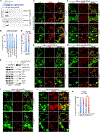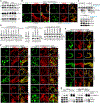MISTERMINATE Mechanistically Links Mitochondrial Dysfunction with Proteostasis Failure
- PMID: 31378462
- PMCID: PMC7362879
- DOI: 10.1016/j.molcel.2019.06.031
MISTERMINATE Mechanistically Links Mitochondrial Dysfunction with Proteostasis Failure
Abstract
Mitochondrial dysfunction and proteostasis failure frequently coexist as hallmarks of neurodegenerative disease. How these pathologies are related is not well understood. Here, we describe a phenomenon termed MISTERMINATE (mitochondrial-stress-induced translational termination impairment and protein carboxyl terminal extension), which mechanistically links mitochondrial dysfunction with proteostasis failure. We show that mitochondrial dysfunction impairs translational termination of nuclear-encoded mitochondrial mRNAs, including complex-I 30kD subunit (C-I30) mRNA, occurring on the mitochondrial surface in Drosophila and mammalian cells. Ribosomes stalled at the normal stop codon continue to add to the C terminus of C-I30 certain amino acids non-coded by mRNA template. C-terminally extended C-I30 is toxic when assembled into C-I and forms aggregates in the cytosol. Enhancing co-translational quality control prevents C-I30 C-terminal extension and rescues mitochondrial and neuromuscular degeneration in a Parkinson's disease model. These findings emphasize the importance of efficient translation termination and reveal unexpected link between mitochondrial health and proteome homeostasis mediated by MISTERMINATE.
Keywords: CAT-tailing; MISTERMINATE; PINK1/Parkin; Parkinson’s disease; RQC; mitochondrial stress; neurodegeneration; proteostasis; ribosome stalling; translation termination.
Copyright © 2019 Elsevier Inc. All rights reserved.
Conflict of interest statement
DECLARATION OF INTERESTS
The authors declare no competing interests.
Figures







Similar articles
-
Mechanisms Linking Mitochondrial Dysfunction and Proteostasis Failure.Trends Cell Biol. 2020 Apr;30(4):317-328. doi: 10.1016/j.tcb.2020.01.008. Epub 2020 Feb 12. Trends Cell Biol. 2020. PMID: 32200806 Free PMC article. Review.
-
Alternative oxidase rescues mitochondria-mediated dopaminergic cell loss in Drosophila.Hum Mol Genet. 2012 Jun 15;21(12):2698-712. doi: 10.1093/hmg/dds096. Epub 2012 Mar 7. Hum Mol Genet. 2012. PMID: 22398207
-
Ubiquitination of ABCE1 by NOT4 in Response to Mitochondrial Damage Links Co-translational Quality Control to PINK1-Directed Mitophagy.Cell Metab. 2018 Jul 3;28(1):130-144.e7. doi: 10.1016/j.cmet.2018.05.007. Epub 2018 May 31. Cell Metab. 2018. PMID: 29861391 Free PMC article.
-
Mitochondrial protein import regulates cytosolic protein homeostasis and neuronal integrity.Autophagy. 2018;14(8):1293-1309. doi: 10.1080/15548627.2018.1474991. Epub 2018 Jul 21. Autophagy. 2018. PMID: 29909722 Free PMC article.
-
mPOS is a novel mitochondrial trigger of cell death - implications for neurodegeneration.FEBS Lett. 2018 Mar;592(5):759-775. doi: 10.1002/1873-3468.12894. Epub 2017 Nov 14. FEBS Lett. 2018. PMID: 29090463 Free PMC article. Review.
Cited by
-
Ribosome-associated quality-control mechanisms from bacteria to humans.Mol Cell. 2022 Apr 21;82(8):1451-1466. doi: 10.1016/j.molcel.2022.03.038. Mol Cell. 2022. PMID: 35452614 Free PMC article. Review.
-
Inefficient quality control of ribosome stalling during APP synthesis generates CAT-tailed species that precipitate hallmarks of Alzheimer's disease.Acta Neuropathol Commun. 2021 Oct 18;9(1):169. doi: 10.1186/s40478-021-01268-6. Acta Neuropathol Commun. 2021. PMID: 34663454 Free PMC article.
-
ANKZF1 helps to eliminate stress-damaged mitochondria by LC3-mediated mitophagy.Cell Death Discov. 2025 Jul 29;11(1):349. doi: 10.1038/s41420-025-02638-y. Cell Death Discov. 2025. PMID: 40730577 Free PMC article.
-
Mechanochemical forces regulate the composition and fate of stalled nascent chains.bioRxiv [Preprint]. 2024 Oct 14:2024.08.02.606406. doi: 10.1101/2024.08.02.606406. bioRxiv. 2024. PMID: 39131335 Free PMC article. Preprint.
-
Protocol for identification of NEMF-mediated C-terminal extensions on mitochondrial nonstop proteins via customized MS/MS spectra database searching.STAR Protoc. 2024 Dec 20;5(4):103366. doi: 10.1016/j.xpro.2024.103366. Epub 2024 Oct 11. STAR Protoc. 2024. PMID: 39395174 Free PMC article.
References
-
- Bi X, Jones T, Abbasi F, Lee H, Stultz B, Hursh DA, and Mortin MA (2005). Drosophila caliban, a nuclear export mediator, can function as a tumor suppressor in human lung cancer cells. Oncogene 24, 8229–8239. - PubMed
-
- Bossy-Wetzel E, Schwarzenbacher R, and Lipton SA (2004). Molecular pathways to neurodegeneration. Nat. Med 10 (Suppl), S2–S9. - PubMed
Publication types
MeSH terms
Substances
Grants and funding
LinkOut - more resources
Full Text Sources
Medical
Molecular Biology Databases
Miscellaneous

